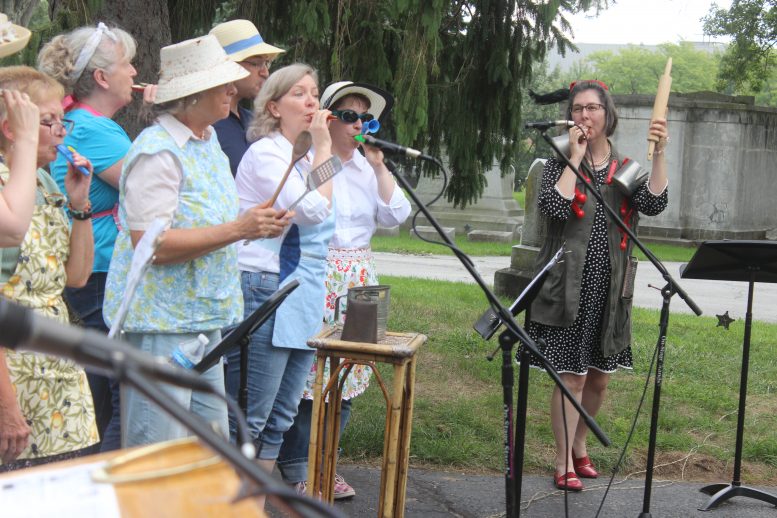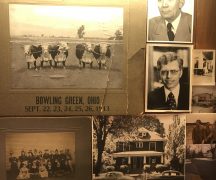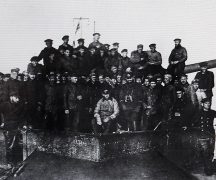By DAVID DUPONT
BG Independent News
After the armistice that ended World War I American longed to return to normalcy.
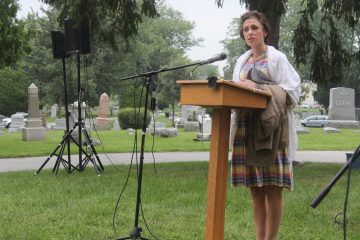
Stephanie Truman as Lizzie Fuller
What did normalcy look like in Wood County?
Maybe, being a member of the Bachelor’s Girl Club.
Maybe playing in a church band, or a kazoo orchestra.
Maybe helping couples get quickie marriages.
Maybe helping a neighboring farmer from losing his place.
Or maybe putting an ax to kegs of illegal booze.
Those were some of the ways local residents responded to the time between the end of the war to end all wars and the beginning of World War II. Eight actors depicted these real life characters Sunday in Bowling Green’s Oak Grove Cemetery in the Living History presentation. This was the 15th such event presented by the Wood County Historical Society. And as has been the case in the past several years, the presentation took its theme from the current exhibit at the Historical Museum, “The Return to Normalcy: A Life of Leisure in Wood County.”
Through the stories of seven individuals and one married couple, those in attendance, many with family ties to the honorees, got an intimate look at a time 90 years ago.
While each story was unique, certain themes ran through the stories – people who lost spouses didn’t stay unmarried for long, church life was central to most of the stories, and several of the women loved their gardens.

Presenters chat before the start of the Living History program at Oak grove Cemetery.
One of those was Lizzie Fuller, portrayed by Stephanie Truman, who found flowers were an expression of God’s creation. “I loved getting my hands dirty.”
She was a deeply religious woman at a time when women were expected to be “quiet and raise virtuous children.”
There were limits though. She live in Grand Rapids, which had a reputation as a wild canal town, where men would carouse in local speakeasies. That included not just those who came to town as workers on the canal but also local men, and even young women.
So one night, a group of women from the Women’s Christian Temperance Society, dressed as men invaded these speakeasies with axes and attacked the containers of liquor. Fuller was coy as to whether she was one of those attacking the speakeasy, but it seemed clear she was.
But she had to admit that this action may have a cautionary message to some local men, the establishments were open the night after the raid.
While these temperance activists are often lampooned, then and now, Truman’s portrayal did justice to Fuller’s great dignity and seriousness.
Wallace Kramp, portrayed by Michael Ginnetti, was also an unlikely rebel. A local farmer, he thrived during World War I. Exempt from the draft because he was a farmer, he and others benefited by the disruption of production in Europe because of the war.
Afterward though farmers found that there was not the demand for their increased production. Their struggles got harder when the Depression hit the rest of the country.
When Kramp suffered from appendicitis matters became critical. He faced an unsympathetic finance officer who insisted he pay his debt.
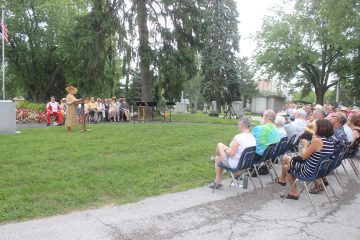
Crowd listens to Dinah Vincent portray Nettie Willard Lincoln.
So Kramp was forced to put all his property up to be auctioned with his debt covered by whatever was raised. However, his fellow farmers had other ideas. “We were feeling desperate and angry.” They started bidding at a penny, and the prices never rose to more than a few cents.
The loan officer who was on hand at one point started bidding up some equipment by dollar amounts, but threatening rumbles rolled through the assembled crowd. Rumor had it, the script said, that there was a bucket of tar and some feathers handy.
The sheriff advised the loan officer to leave and his bid was withdrawn. At the end of the day, the auction raised $14.31.
Then a hat was passed around to collect money to help Kramp. The collection brought in about $270. People valued him more than his possessions, Kramp reflected.
These penny auctions happened again and again, first locally, and then spreading nationally. Eventually farming turned around again in part because of demand created by World War II. Kramp retired comfortably in Bowling Green.
Paul Fuller, portrayed by Thomas Edge, engaged in a different sort of enterprise. In the 1930s, Wood County was known as a place where a couple could get married quickly. The residency laws were rather loose, and people like Paul Fuller were all too willing to help couples make the necessary arrangements – paperwork, finding a minister or justice of the peace to officiate, buying a ring or keepsake, or booking a room. All this in the hopes of a generous tip.
The hustle required having people around town who could spot such couples and steer them to Fuller. The most famous groom was Teamster leader Jimmy Hoffa, who married his wife Pauline in 1937. They’d met on a picket line in Detroit.
The laws were changed ending the wedding broker business, but Fuller continued to thrive as an advertising manager with the Sentinel-Tribune.
The program was bookended by people with musical stories.
Cleve Paton, of A Joyful Noise, entertained before the program started. Then in full band regalia he portrayed Raymond George.
Born in 1889, George took to music early learning organ, violin and clarinet. He started out playing in the local kids band, and then the Bowling Green military band. He “found wings” as the conductor of the Methodist Church band. He made sure all five of his children learned instruments and the need to “practice, practice, practice.” They all sang in the church choir as well.
He recalled that family reunions always began with hymn sings, and often included instrumental “jam sessions.”
Georgia Sargent Waugh’s musical expressions were quirkier. Before she got married at 27, she was a member of the Bachelor Girls Club. They did needlework, sang, and dined together. After she married, she became a member of the Portage Township Homemakers, a group sponsored by the extension service.
Waugh, portrayed by Michele Raine, became of the leader of the Homemakers’ kazoo orchestra, which played throughout the county. And at the concerts they received prizes – a silver measuring cup in Bloomdale, a coffee percolator in Jerry City, and a silver-plated nutmeg grater in Cygnet.
The Virginia Theater in North Baltimore outlasted the kazoo orchestra, though it closed last spring.
The theater was opened in 1936 by Ernest and Viola Walter, portrayed David and Ellin Stoots, shortly after they got married.
The theater then featured the latest in furnishings, including a soundproof room for mothers with fussy children. The Walters lived upstairs from the theater.
The family had to flee from a fire. But the theater was spared and with help remained open.
Nettie Willard Lincoln, portrayed by Dinah Vincent, also had to flee a burning home. The southern socialite, born in 1863, had moved to Bowling Green as a 20-year-old to teach at Ridge school but a year later she married a doctor, Joseph Lincoln, a widower with two children and 19 years her senior. They built a large home at 350 N. Main St. that took five years to construct at a cost of $14,000. It was intended to allow Lincoln to entertain in the “southern style” she grew up with. No sooner had they moved in then it burned. They rebuilt.
In 1905, Lincoln helped establish the Shakespeare Roundtable and was one of the members of the group that collected 300 books in 1911 to found the public library.
She later took up the fashionable hobby of painting on porcelain. She didn’t stop there, and went on to paint landscapes, including those she saw during the couple’s stays in California, where she was part of an artist colony.
Several of her paintings were exhibited at the Toledo Museum of Art.
Her presentation ended with her envisioning a time when she would be buried in Oak Grove Cemetery “under these magnificent trees in this wonderful town I love so much.”

